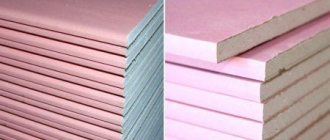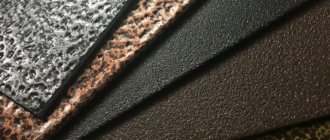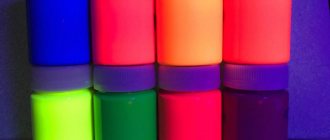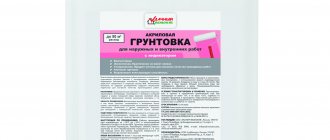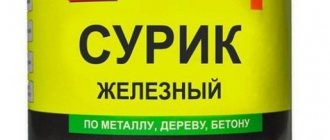What is silicone paint
Organosilicon paint is a coloring material created on the basis of polyorganosiloxane polymers. A multicomponent suspension containing various coloring pigments, to which modifying additives, silicone resins and organic solvents can be added depending on the desired performance characteristics.
There are two types of silicone paint:
- With limited heat resistance. For the most part, it is used for painting building facades and is available in a wide palette. Limitations are associated with the heat resistance of the pigments that make up the enamel. At temperatures above +150 ˚C, the pigment structure is destroyed and the coating loses its color. The service life of this category of enamels is 10 – 15 years.
- Heat resistant. Used to prevent corrosion on steel, titanium and aluminum surfaces, to protect industrial equipment parts from prolonged exposure to temperature or humid environments. This category of enamel is often used for painting stoves, chimneys, fireplaces and other heating equipment in order to avoid reducing the strength of materials susceptible to salt crystallization.
Preparation of paints for application to surfaces
Organosilicon enamel is sold ready-to-use, and no manipulations are required before use. If for some reason it has thickened, it can be diluted to the required consistency with xylene or toluene. After the thinners are added to the main coloring composition, the resulting mixture must be thoroughly mixed.
It is not recommended to dilute varnishes and paints in order to reduce their consumption, since in this case the film formed by diluted paint will have lower strength and quality indicators, and its decorativeness and water resistance will decrease.
Compound
The main advantage of organosilicon paint - its heat resistance - is achieved due to the greater binding energy of silicon and oxygen atoms in the macromolecule of the organosilicon compound compared to a conventional carbon-containing polymer.
Anti-corrosion substances are added to the silicone paint to improve protection from changing weather conditions, ethylcellulose and acrylic varnishes to reduce drying time, carbide layers and epoxy resins for better resistance to aggressive mechanical damage.
A variety of color shades is achieved by adding organic and inorganic pigments to the enamel structure, which do not lose color at temperatures up to +150˚C.
Water repellents
The features and properties possessed by organosilicon materials have made it possible to use polymers to provide protective waterproofing functions using the hydrophobization method. This method very efficiently and effectively solves the issue of water resistance of various surfaces with the help of water repellents .
A water repellent is a type of ready-made solution or concentrated composition that has a water-repellent effect without creating a surface film layer.
Surface treatment by hydrophobization involves the use of organosilicon and acrylic solutions to impregnate various surfaces.
- increases the strength of the material impregnated with the composition,
- evaporates moisture from it,
- At the same time, it maintains the vapor permeability of carefully treated surfaces,
- protects it from dust contamination, the appearance of salt stains,
- allows you to significantly reduce the costs of all existing types of paints and varnishes.
Main characteristics
Organosilicon paints are used for exterior decoration. This category of paints and varnishes accordingly has the characteristics necessary for painting outdoor surfaces:
- UV resistance. High resistance to sunlight;
- Water permeability (absorption). After the paint has completely dried, no water penetration is observed;
- Abrasion resistance: durability reaches more than three and a half thousand cycles;
- Drying time. Dries completely within two hours after applying the last coat;
- Heat resistance. Heat-resistant enamels can withstand temperatures up to +600˚C.
Surface painting
Silicone-based enamels, varnishes and paints can be applied:
- airbrush;
- spray gun;
- manual painting with a brush or roller;
- by immersing the product in a dye.
Coloring can be done at ambient temperatures from –20 to +40 degrees Celsius. The only prerequisite is that the surface to be painted must be completely dry.
Metal surfaces are painted in two or three layers; concrete, plaster, cement and brick are painted in three layers. Before applying each subsequent layer, the previous one is allowed to dry. The more porous and loose the base near the surface, the higher the consumption of paints and varnishes.
Such remarkable properties of organosilicon enamels and paints, their high level of heat resistance, durability and special strength, have made them especially in demand in production, construction and everyday life.
Advantages and disadvantages
Advantages of organosilicon coatings:
- Painting work can be carried out at temperatures from + 40 to -20 ˚C;
- The coating can withstand extreme temperature conditions (from -60 to +150, +600 ˚C depending on heat resistance);
- Long service life: more than 15 years;
- Excellent protection against corrosion and moisture ingress;
- Large selection of colors;
- Good electrical insulating properties;
- Relatively low price;
- Insoluble in most solvents and chemically inert towards most chemical reagents.
Disadvantages of organosilicon coatings:
- The strong toxic fumes released by the composition when drying are very harmful to humans;
- Direct contact with silicone paint for a long time affects human mucous membranes and is harmful to health;
- Organosilicon can only be used for outdoor use;
- Do not apply to wet surfaces: after rain, snow or frost.
Advantages and disadvantages
Paints and varnishes related to the organosilicon type, except for those inherent in them
properties also have their own distinctive features, advantages and disadvantages relative to other types of paints and enamels that are used for painting surfaces.
The main advantages of existing silicone paints are the advantages achieved during their production:
- heat resistance;
- moisture resistance and water resistance;
- fire resistance;
- light fastness, resistance to ultraviolet rays;
- atmospheric stability;
- chemical resistance;
- quick drying of the painted surface;
- frost resistance;
- wide range of colors;
- low consumption of materials when painting;
- the possibility of painting the surface at negative temperatures reaching -20 degrees;
- providing effective anti-corrosion protection to metal products.
Among the disadvantages of industrially produced silicone paints, the following should be noted:
- toxicity of fumes that are released during the drying process of the material;
- negative effects on the human body due to prolonged contact with enamels;
- use of paints and varnishes of this type exclusively for exterior work.
Organosilicon paint and varnish compositions differ from most similar types of paints in their low price, as well as in the process of adding additives to the materials, a number of very important parameters that are used in many industries and the national economy.
Unlike other types of paint, organosilicon paint and varnish material does not require priming of the surface to be painted, and the chromium compounds introduced into the composition make the enamels very resistant to mechanical stress. Similar types of paints do not have such capabilities and characteristics.
Where is it used?
Organosilicon facade paint is widely used in construction for decorative weather-resistant painting of external surfaces of buildings and structures. It is also used for the protective coating of brick, concrete, stone, plastered wood and pre-primed metal building elements.
The hydrophobic properties of the paint are used for protective painting of building foundations and slate surfaces.
Silicone enamel with high heat resistance is widely used in industry for painting and protecting various heating devices, parts of electric motors, transformers and internal combustion engines. As a protection against water and metal corrosion, it is used in bridge construction, shipbuilding, and for painting supports and port structures.
It has found wide application in all industrial production and national economic enterprises that require the operation of mechanisms, devices, tanks and premises in extreme temperature or atmospheric conditions.
Application
Thanks to the properties acquired during the production of organosilicon compositions, paint and varnish products of this type have gained enormous popularity in the field of external repair, construction and finishing work.
Construction organizations have realized that paints with such excellent characteristics will be able to provide not only high-quality and reliable protection of surfaces, but also
perfectly decorate the walls of buildings under construction.
Wide range of possibilities and affordable prices have made it possible to use silicone paints in such important areas as:
- construction;
- shipbuilding;
- nuclear power;
- port structures;
- power plants;
- mechanical engineering;
- chemical industry;
- gas and oil industry;
- road markings;
- high voltage lines;
- waterproofing;
- bridges;
- supports;
- pipelines;
- chimneys;
- hydraulic structures.
Organosilicon paint and varnish material is used to cover main pipelines and building plaster, paint bridges and brick buildings, apply it to hot surfaces of chimneys and paint cold pipelines transporting refrigerants.
The process of painting surfaces is practically no different from painting with other types of paints and varnishes. The same spray gun, the same brushes, rollers, airbrush. Enamels can be purchased completely ready for use, which means there is no need to manipulate the silicone composition.
Thickened paint is diluted with xylene, and toluene is also used for this purpose. But excessive dilution of paints with the noble goal of reducing its costs is not advisable due to the loss of the composition of its original properties and deterioration in the quality of the product used.
You should not paint damp and wet surfaces with silicone paints; the moisture present will dilute the still raw paint material and it will also lose the very valuable properties it has acquired.
Paint is also used in the food industry, but there are established sanitary standards and requirements for the use of this type of product. According to established standards, the material is divided into two types:
- paints and varnishes that can be used on all surfaces without limitation;
- paints for which there are restrictions.
The first type includes compounds used in public buildings, schools, child care institutions, and hospitals. These paints can be used to paint surfaces in the kitchen, dining room, and rooms. The safety and quality of the material is guaranteed by relevant legislation.
Read our article on how to choose façade paint.
The second type involves its use only for certain types of work permitted by sanitary standards. A list of possible uses of such organosilicon paints can be found in the instructions for use on cans.
Advantages and disadvantages
Silicone enamels have their own characteristics, as well as pros and cons unique to this coating. They have the following advantages:
- moisture resistance and water resistance;
- heat resistance;
- resistance to fire and ultraviolet rays;
- light fastness and weather resistance;
- quick drying after painting;
- varied color palette;
- not afraid of chemical exposure;
- minimum consumption;
- effective anti-corrosion protection for metal surfaces;
- Possibility of painting at sub-zero temperatures.
In addition to the characteristic features and positive properties, organosilicon materials have their drawbacks. Among the disadvantages:
- during the drying process, toxic fumes are released;
- with prolonged contact, paints have a negative effect on the human body;
- They are intended for outdoor use only.
Paint and varnish compositions of the organosilicon group are widely used in industry. Due to their composition, they differ from other analogues. They do not require priming the working surface before painting.
